Antibody Market Size 2025-2029
The antibody market size is valued to increase by USD 8.96 billion, at a CAGR of 8.3% from 2024 to 2029. Technological advancements and innovation in antibody engineering will drive the antibody market.
Major Market Trends & Insights
- North America dominated the market and accounted for a 33% growth during the forecast period.
- By Type - Monoclonal antibodies segment was valued at USD 6.57 billion in 2023
- By Therapeutic Area - Oncology segment accounted for the largest market revenue share in 2023
Market Size & Forecast
- Market Opportunities: USD 106.55 million
- Market Future Opportunities: USD 8958.00 million
- CAGR from 2024 to 2029 : 8.3%
Market Summary
- The market is experiencing significant growth, with recent estimates suggesting a value of USD150 billion by 2025. This expansion is driven by the relentless pursuit of technological advancements and innovation in antibody engineering. Next-generation antibody drug constructs, such as bispecific and conjugated antibodies, are gaining traction due to their enhanced specificity and efficacy. However, the market faces intense pricing pressure and payer scrutiny, necessitating cost-effective solutions and value-based pricing strategies.
- Despite these challenges, the market continues to evolve, offering immense opportunities for growth and transformation. The race to develop novel therapeutic applications and improve existing treatments fuels the industry's progress, ensuring a dynamic and ever-evolving landscape.
What will be the Size of the Antibody Market during the forecast period?
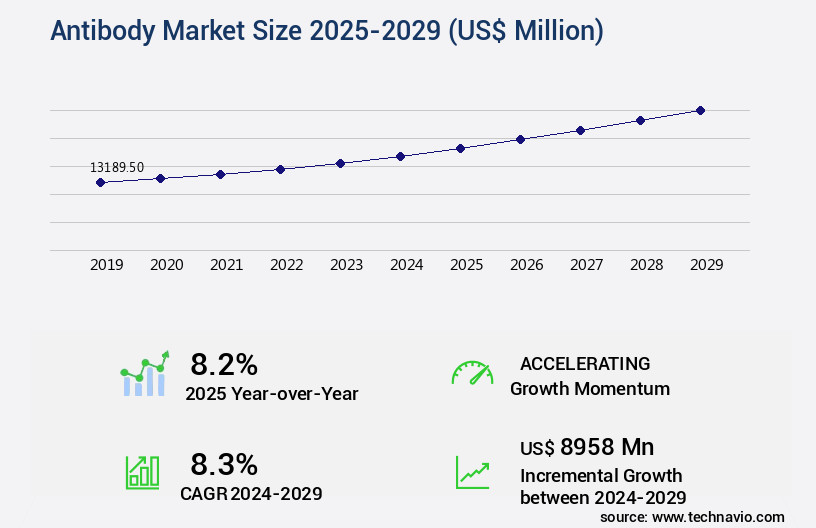
Get Key Insights on Market Forecast (PDF) Request Free Sample
How is the Antibody Market Segmented ?
The antibody industry research report provides comprehensive data (region-wise segment analysis), with forecasts and estimates in "USD million" for the period 2025-2029, as well as historical data from 2019-2023 for the following segments.
- Type
- Monoclonal antibodies
- Polyclonal antibodies
- Others
- Therapeutic Area
- Oncology
- Autoimmune diseases
- Infectious diseases
- Cardiovascular diseases
- Others
- Application
- Therapeutic
- Diagnostic
- Research
- Geography
- North America
- Europe
- APAC
- Australia
- China
- India
- Japan
- South Korea
- Rest of World (ROW)
By Type Insights
The monoclonal antibodies segment is estimated to witness significant growth during the forecast period.
The market is characterized by the continuous evolution and maturation of monoclonal antibody (mAb) production technologies, which remain the cornerstone of this burgeoning industry. MAbs, derived from a single B cell clone, exhibit unparalleled specificity, binding to precise molecular targets or epitopes with high affinity. This specificity underpins their diverse mechanisms of action, which include blocking signaling receptors, triggering antibody-dependent cell-mediated cytotoxicity (ADCC), neutralizing pathogens, and inhibiting immune checkpoints in cancer therapy. Advancements in immunogenicity assessment methods, such as flow cytometry analysis and ELISA antibody quantification, ensure the highest quality mAb production. Biopharmaceutical manufacturing techniques, including cell culture optimization, protein purification, and downstream processing, have been refined to maximize yield and minimize production costs.
Affinity maturation processes, like complement-dependent cytotoxicity and phage display technology, enable the development of high-affinity mAbs with improved therapeutic efficacy. Innovations in antibody engineering techniques, such as immunoglobulin structure modifications and epitope mapping, expand the potential applications of mAbs. Furthermore, the development of drug delivery systems, including hybridoma cell lines and targeted therapy, enhances the therapeutic potential of mAbs. These advancements have led to a thriving market, with an estimated 10% compound annual growth rate between 2021 and 2028. Protein-protein interactions, receptor-ligand interactions, and immunoprecipitation assays are crucial tools in the development and analysis of mAbs. Chromatography techniques, bioreactor design, and Antibody Drug Conjugates further expand the capabilities of this versatile class of therapeutics. The immunomodulatory effects of mAbs, as well as their role in clinical trials, continue to drive research and development in this field.
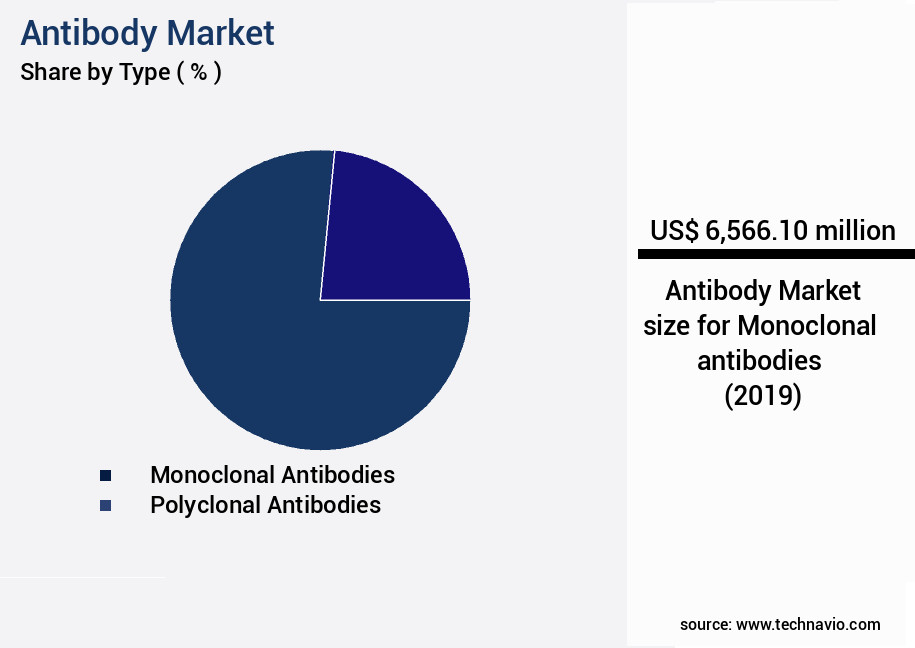
Request Free Sample
The Monoclonal antibodies segment was valued at USD 6.57 billion in 2019 and showed a gradual increase during the forecast period.
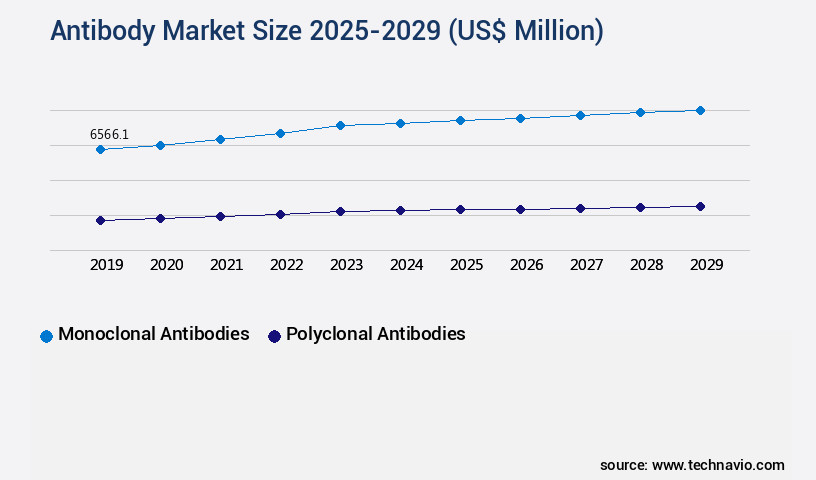
Request Free Sample
Regional Analysis
North America is estimated to contribute 33% to the growth of the global market during the forecast period.Technavio's analysts have elaborately explained the regional trends and drivers that shape the market during the forecast period.
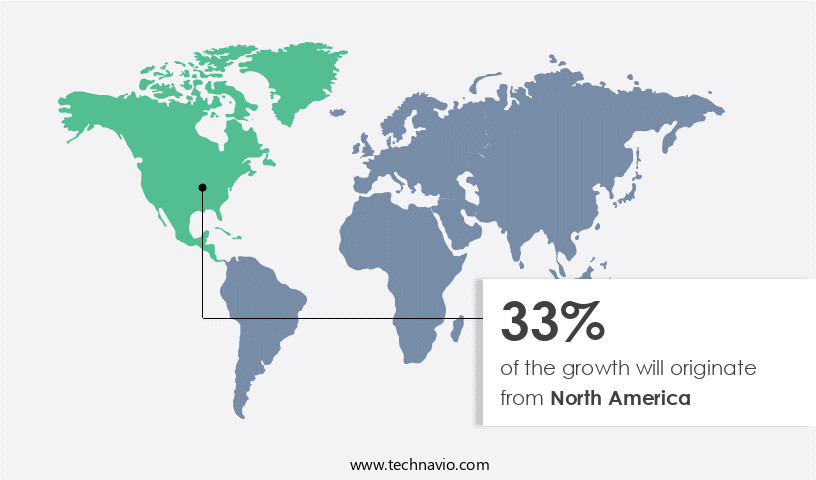
See How Antibody Market Demand is Rising in North America Request Free Sample
Antibodies, a critical component of diagnostic and therapeutic applications, represent a dynamic and evolving market. North America, spearheaded by the United States, reigns as the global leader, accounting for a significant market share. Factors fueling this dominance include the region's highest healthcare expenditure per capita, a robust research and development ecosystem, a clear regulatory framework, and a commercial environment that encourages the adoption of innovative, high-value therapies. The US hosts numerous leading pharmaceutical and biotechnology companies, as well as a thriving network of academic institutions and venture capital-backed startups.
According to recent reports, the global antibodies market size was valued at over USD150 billion in 2020 and is projected to reach USD300 billion by 2028, growing at a steady pace. Europe and Asia Pacific are also emerging as significant contributors to the market, driven by increasing healthcare expenditures, growing research activities, and favorable regulatory environments.
Market Dynamics
Our researchers analyzed the data with 2024 as the base year, along with the key drivers, trends, and challenges. A holistic analysis of drivers will help companies refine their marketing strategies to gain a competitive advantage.
The market is experiencing significant growth due to the increasing demand for therapeutic antibodies in various applications, particularly in immuno-oncology. The development process of therapeutic antibodies involves several stages, including high throughput screening assays for target identification, antibody fragment design, and cell line characterization techniques for producing the desired antibody. Once produced, the antibodies undergo clinical trial design and conduct, with a focus on ensuring pharmacokinetic modeling and simulation to understand their behavior in the body. Antibody-drug conjugates (ADCs) have gained popularity due to their ability to enhance the therapeutic effect through antibody-dependent cellular phagocytosis and fc receptor mediated effector function. The stability of ADCs is crucial, requiring rigorous process analytical technology (PAT) and quality control testing to ensure consistent product quality. Immuno-oncology applications of antibodies also involve biosimilarity assessment methods to compare the therapeutic equivalence of different antibody products. In vivo pharmacokinetic parameters and antigen-antibody binding kinetics are essential in understanding the therapeutic potential of antibodies and optimizing their delivery through drug delivery system design and development. Target specificity and selectivity are critical factors in the success of therapeutic antibodies. Pharmaceutical companies invest in advanced technologies and techniques to ensure the antibodies bind specifically to their targets, minimizing off-target effects and maximizing therapeutic efficacy. The antibody production process validation is also crucial to ensure consistent product quality and safety, with a focus on maintaining the desired antibody structure and function.
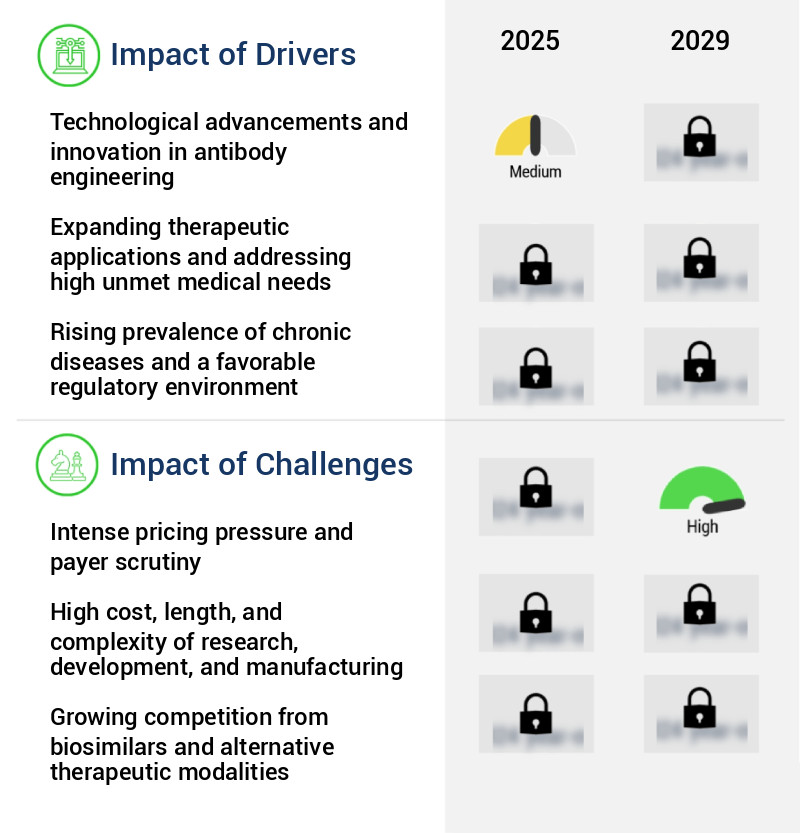
What are the key market drivers leading to the rise in the adoption of Antibody Industry?
- Antibody engineering, driven by technological advancements and innovation in this field, is the primary catalyst fueling market growth.
- The market is undergoing a significant transformation, fueled by advancements in antibody engineering technology. This evolution goes beyond traditional monoclonal antibodies, moving towards more complex and effective constructs. Two noteworthy innovations driving this change are antibody drug conjugates (ADCs) and bispecific antibodies. ADCs, referred to as biological guided missiles, embody the precision medicine of targeted medicine in oncology. They combine the specificity of a monoclonal antibody with a highly potent cytotoxic payload, delivered via a specialized chemical linker.
- Bispecific antibodies, on the other hand, offer the unique ability to bind to two distinct antigens, expanding therapeutic possibilities. These advancements underscore the market's dynamic nature and its potential to tackle previously untreatable diseases.
What are the market trends shaping the Antibody Industry?
- The ascendancy of next-generation antibody constructs represents a significant market trend. These advanced antibody structures are poised to make a notable impact in various industries.
- The market is witnessing a significant shift from traditional monoclonal antibodies to next-generation engineered constructs, such as antibody drug conjugates (ADCs) and bispecific antibodies. This trend signifies a transformative development in therapeutic approaches, aimed at overcoming treatment resistance, augmenting efficacy, and improving safety profiles in intricate diseases, primarily cancer. ADCs epitomize this innovation by linking a powerful cytotoxic agent to a highly specific antibody, acting as biological guided missiles, delivering their payload exclusively to malignant cells. This targeted delivery mechanism minimizes systemic exposure and associated toxicity, enabling the utilization of anti-cancer agents that would otherwise be too toxic for systemic administration.
- The strategic application of these advanced antibody constructs underscores their immense potential in revolutionizing the pharmaceutical landscape.
What challenges does the Antibody Industry face during its growth?
- The intense pricing pressure and scrutiny from payers pose a significant challenge to the industry's growth trajectory. This trend, driven by increasing competition and heightened cost sensitivity among healthcare consumers and insurers, necessitates a strategic response from industry players to maintain profitability and market share.
- The market is undergoing significant transformations, driven by escalating pricing pressures and payer scrutiny. The high costs of innovative antibody therapies, which are often justified by their substantial clinical benefits and extensive research investment, pose a considerable challenge to healthcare budgets worldwide. In response, payers have adopted sophisticated cost-containment strategies, such as restrictive formularies, stringent prior authorization procedures, and aggressive rebate negotiations. These trends reflect the evolving market landscape, shaped by major legislative actions and dynamics aimed at curbing drug expenditures.
- According to recent estimates, the market accounted for over 35% of the global biologics market in 2020, with monoclonal antibodies representing the largest segment. As the market continues to evolve, stakeholders must navigate these complexities to ensure access to effective therapies while managing costs.
Exclusive Technavio Analysis on Customer Landscape
The antibody market forecasting report includes the adoption lifecycle of the market, covering from the innovator's stage to the laggard's stage. It focuses on adoption rates in different regions based on penetration. Furthermore, the antibody market report also includes key purchase criteria and drivers of price sensitivity to help companies evaluate and develop their market growth analysis strategies.
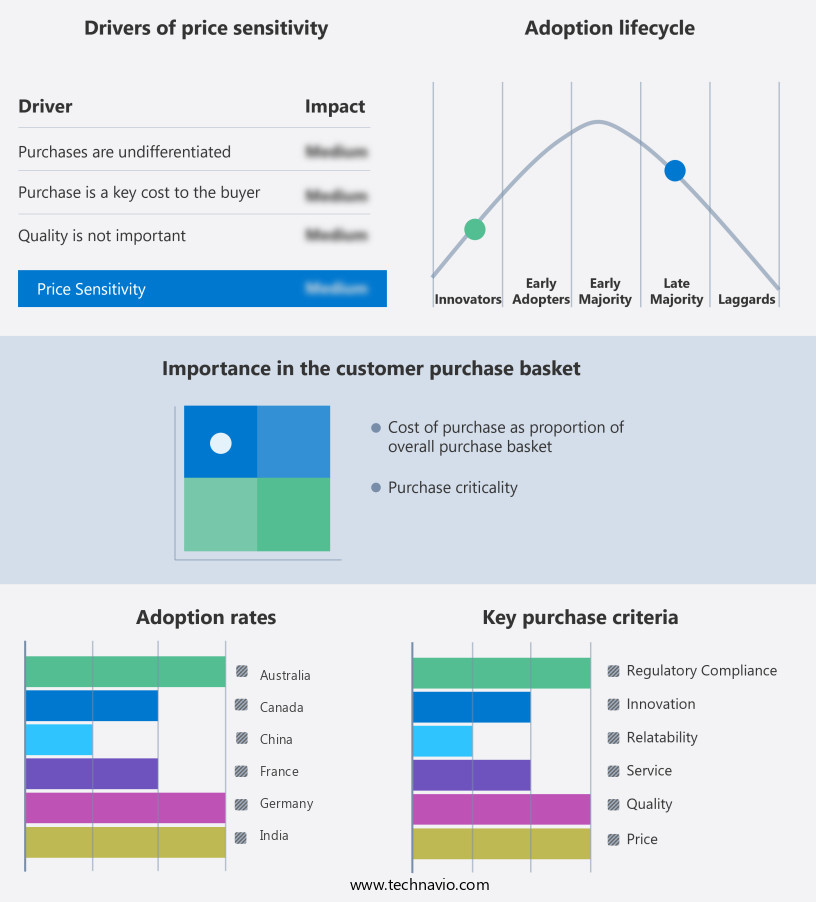
Customer Landscape of Antibody Industry
Competitive Landscape
Companies are implementing various strategies, such as strategic alliances, antibody market forecast, partnerships, mergers and acquisitions, geographical expansion, and product/service launches, to enhance their presence in the industry.
AbbVie Inc. - The pharmaceutical company is a leading innovator in the immunology sector, with a robust pipeline of drugs including Humira (adalimumab), Skyrizi (risankizumab), and Rinvoq (upadacitinib, a JAK inhibitor). Notably, Rinvoq represents a significant addition to their franchise due to its unique mechanism of action as a Janus kinase inhibitor.
The industry research and growth report includes detailed analyses of the competitive landscape of the market and information about key companies, including:
- AbbVie Inc.
- Amgen Inc.
- AstraZeneca Plc
- Bio Rad Laboratories Inc.
- BioVendor Laboratorni medicina AS
- Cell Signaling Technology Inc.
- Celltrion Co. Ltd.
- Creative Biolabs
- Danaher Corp.
- F. Hoffmann La Roche Ltd.
- GenScript Biotech Corp.
- Johnson and Johnson Services Inc.
- Leinco Technologies Inc.
- Merck and Co. Inc.
- Novartis AG
- Novus Biologicals
- Pfizer Inc.
- Proteintech Group
- Regeneron Pharmaceuticals Inc.
- Sanofi SA
- Sino Biological Inc.
- Thermo Fisher Scientific Inc.
Qualitative and quantitative analysis of companies has been conducted to help clients understand the wider business environment as well as the strengths and weaknesses of key industry players. Data is qualitatively analyzed to categorize companies as pure play, category-focused, industry-focused, and diversified; it is quantitatively analyzed to categorize companies as dominant, leading, strong, tentative, and weak.
Recent Development and News in Antibody Market
- In January 2024, Roche Holding AG announced the launch of its new diagnostic test, Elecsys® CSF Biomarker II, which utilizes antibodies for the detection of Alzheimer's disease. This development marks a significant stride in the diagnostics sector of the market (Roche Press Release, 2024).
- In March 2024, Amgen Inc. And Merck KGaA entered into a strategic collaboration to co-develop and commercialize up to five investigational antibody therapies for various diseases. This partnership is expected to expand the reach and influence of both companies in the antibody therapeutics market (Amgen & Merck KGaA Press Release, 2024).
- In May 2024, AstraZeneca Plc completed the acquisition of Alexion Pharmaceuticals Inc. For approximately USD39 billion. This acquisition adds Alexion's portfolio of complement inhibitors and rare disease therapies, strengthening AstraZeneca's position in the antibody therapeutics market (AstraZeneca Press Release, 2024).
- In January 2025, the U.S. Food and Drug Administration (FDA) granted accelerated approval to Regeneron Pharmaceuticals Inc.'s Libtayo® (cemiplimab-rwlc) for the treatment of advanced cutaneous squamous cell carcinoma. Libtayo is an engineered monoclonal antibody, marking a key regulatory approval in the antibody therapeutics market (FDA Press Release, 2025).
Dive into Technavio's robust research methodology, blending expert interviews, extensive data synthesis, and validated models for unparalleled Antibody Market insights. See full methodology.
|
Market Scope
|
|
Report Coverage
|
Details
|
|
Page number
|
246
|
|
Base year
|
2024
|
|
Historic period
|
2019-2023 |
|
Forecast period
|
2025-2029
|
|
Growth momentum & CAGR
|
Accelerate at a CAGR of 8.3%
|
|
Market growth 2025-2029
|
USD 8958 million
|
|
Market structure
|
Fragmented
|
|
YoY growth 2024-2025(%)
|
8.2
|
|
Key countries
|
US, China, Germany, Japan, UK, Canada, India, France, Australia, and South Korea
|
|
Competitive landscape
|
Leading Companies, Market Positioning of Companies, Competitive Strategies, and Industry Risks
|
Request Free Sample
Research Analyst Overview
- The market continues to evolve, driven by advancements in immunogenicity assessment methods and monoclonal antibody production. FC receptor binding and flow cytometry analysis play crucial roles in assessing the potency and specificity of antibodies. The affinity maturation process, antibody drug conjugates, and cell culture optimization are essential elements in biopharmaceutical manufacturing. Protein purification techniques, such as chromatography and bioreactor design, are integral to producing therapeutic antibodies with high efficacy. Protein-protein interactions, immunomodulatory effects, and epitope mapping techniques are essential in understanding the mechanisms of action and optimizing antibody engineering techniques. Phage display technology and immunoprecipitation assays are valuable tools in antibody discovery and characterization.
- Clinical trial data and drug delivery systems are critical components in bringing new antibody-based therapies to market. Targeted therapy, utilizing Cell Surface Markers and receptor-ligand interactions, is a growing application of antibodies in medicine. The market is expected to grow at a robust rate, with industry analysts projecting a 12% annual increase in demand for antibody-based therapeutics. For instance, a recent study reported a 25% sales increase for a monoclonal antibody treatment in oncology. The ongoing research and development efforts in this field promise to unveil new applications and expand the horizons of antibody technology.
What are the Key Data Covered in this Antibody Market Research and Growth Report?
-
What is the expected growth of the Antibody Market between 2025 and 2029?
-
What segmentation does the market report cover?
-
The report is segmented by Type (Monoclonal antibodies, Polyclonal antibodies, and Others), Therapeutic Area (Oncology, Autoimmune diseases, Infectious diseases, Cardiovascular diseases, and Others), Application (Therapeutic, Diagnostic, and Research), and Geography (North America, Europe, Asia, and Rest of World (ROW))
-
Which regions are analyzed in the report?
-
What are the key growth drivers and market challenges?
-
Who are the major players in the Antibody Market?
-
AbbVie Inc., Amgen Inc., AstraZeneca Plc, Bio Rad Laboratories Inc., BioVendor Laboratorni medicina AS, Cell Signaling Technology Inc., Celltrion Co. Ltd., Creative Biolabs, Danaher Corp., F. Hoffmann La Roche Ltd., GenScript Biotech Corp., Johnson and Johnson Services Inc., Leinco Technologies Inc., Merck and Co. Inc., Novartis AG, Novus Biologicals, Pfizer Inc., Proteintech Group, Regeneron Pharmaceuticals Inc., Sanofi SA, Sino Biological Inc., and Thermo Fisher Scientific Inc.
Market Research Insights
- The market is a dynamic and continually advancing sector, driven by ongoing research and development in various areas. Two significant aspects of this field include the application of molecular modeling in lead optimization and the integration of half-life extension strategies in antibody engineering. For instance, the use of molecular modeling has enabled the design of antibodies with improved specificity and affinity, leading to more effective therapeutic outcomes.
- Furthermore, the market is expected to grow at a steady pace, with industry experts projecting a compound annual growth rate of approximately 10%. This expansion is attributed to the increasing demand for novel therapeutic solutions, particularly in the areas of cancer treatment and infectious diseases.
We can help! Our analysts can customize this antibody market research report to meet your requirements.
Get in touch
1 Executive Summary
- 1.1 Market overview
- Executive Summary - Chart on Market Overview
- Executive Summary - Data Table on Market Overview
- Executive Summary - Chart on Global Market Characteristics
- Executive Summary - Chart on Market by Geography
- Executive Summary - Chart on Market Segmentation by Type
- Executive Summary - Chart on Market Segmentation by Therapeutic Area
- Executive Summary - Chart on Market Segmentation by Application
- Executive Summary - Chart on Incremental Growth
- Executive Summary - Data Table on Incremental Growth
- Executive Summary - Chart on Company Market Positioning
2 Technavio Analysis
- 2.1 Analysis of price sensitivity, lifecycle, customer purchase basket, adoption rates, and purchase criteria
- Analysis of price sensitivity, lifecycle, customer purchase basket, adoption rates, and purchase criteria
- 2.2 Criticality of inputs and Factors of differentiation
- Overview on criticality of inputs and factors of differentiation
- 2.3 Factors of disruption
- Overview on factors of disruption
- 2.4 Impact of drivers and challenges
- Impact of drivers and challenges in 2024 and 2029
3 Market Landscape
- 3.1 Market ecosystem
- Parent Market
- Data Table on - Parent Market
- 3.2 Market characteristics
- Market characteristics analysis
4 Market Sizing
- 4.1 Market definition
- Offerings of companies included in the market definition
- 4.2 Market segment analysis
- 4.4 Market outlook: Forecast for 2024-2029
- Chart on Global - Market size and forecast 2024-2029 ($ million)
- Data Table on Global - Market size and forecast 2024-2029 ($ million)
- Chart on Global Market: Year-over-year growth 2024-2029 (%)
- Data Table on Global Market: Year-over-year growth 2024-2029 (%)
5 Historic Market Size
- 5.1 Global Antibody Market 2019 - 2023
- Historic Market Size - Data Table on Global Antibody Market 2019 - 2023 ($ million)
- 5.2 Type segment analysis 2019 - 2023
- Historic Market Size - Type Segment 2019 - 2023 ($ million)
- 5.3 Therapeutic Area segment analysis 2019 - 2023
- Historic Market Size - Therapeutic Area Segment 2019 - 2023 ($ million)
- 5.4 Application segment analysis 2019 - 2023
- Historic Market Size - Application Segment 2019 - 2023 ($ million)
- 5.5 Geography segment analysis 2019 - 2023
- Historic Market Size - Geography Segment 2019 - 2023 ($ million)
- 5.6 Country segment analysis 2019 - 2023
- Historic Market Size - Country Segment 2019 - 2023 ($ million)
6 Five Forces Analysis
- 6.1 Five forces summary
- Five forces analysis - Comparison between 2024 and 2029
- 6.2 Bargaining power of buyers
- Bargaining power of buyers - Impact of key factors 2024 and 2029
- 6.3 Bargaining power of suppliers
- Bargaining power of suppliers - Impact of key factors in 2024 and 2029
- 6.4 Threat of new entrants
- Threat of new entrants - Impact of key factors in 2024 and 2029
- 6.5 Threat of substitutes
- Threat of substitutes - Impact of key factors in 2024 and 2029
- 6.6 Threat of rivalry
- Threat of rivalry - Impact of key factors in 2024 and 2029
- 6.7 Market condition
- Chart on Market condition - Five forces 2024 and 2029
7 Market Segmentation by Type
- 7.1 Market segments
- Chart on Type - Market share 2024-2029 (%)
- Data Table on Type - Market share 2024-2029 (%)
- 7.2 Comparison by Type
- Chart on Comparison by Type
- Data Table on Comparison by Type
- 7.3 Monoclonal antibodies - Market size and forecast 2024-2029
- Chart on Monoclonal antibodies - Market size and forecast 2024-2029 ($ million)
- Data Table on Monoclonal antibodies - Market size and forecast 2024-2029 ($ million)
- Chart on Monoclonal antibodies - Year-over-year growth 2024-2029 (%)
- Data Table on Monoclonal antibodies - Year-over-year growth 2024-2029 (%)
- 7.4 Polyclonal antibodies - Market size and forecast 2024-2029
- Chart on Polyclonal antibodies - Market size and forecast 2024-2029 ($ million)
- Data Table on Polyclonal antibodies - Market size and forecast 2024-2029 ($ million)
- Chart on Polyclonal antibodies - Year-over-year growth 2024-2029 (%)
- Data Table on Polyclonal antibodies - Year-over-year growth 2024-2029 (%)
- 7.5 Others - Market size and forecast 2024-2029
- Chart on Others - Market size and forecast 2024-2029 ($ million)
- Data Table on Others - Market size and forecast 2024-2029 ($ million)
- Chart on Others - Year-over-year growth 2024-2029 (%)
- Data Table on Others - Year-over-year growth 2024-2029 (%)
- 7.6 Market opportunity by Type
- Market opportunity by Type ($ million)
- Data Table on Market opportunity by Type ($ million)
8 Market Segmentation by Therapeutic Area
- 8.1 Market segments
- Chart on Therapeutic Area - Market share 2024-2029 (%)
- Data Table on Therapeutic Area - Market share 2024-2029 (%)
- 8.2 Comparison by Therapeutic Area
- Chart on Comparison by Therapeutic Area
- Data Table on Comparison by Therapeutic Area
- 8.3 Oncology - Market size and forecast 2024-2029
- Chart on Oncology - Market size and forecast 2024-2029 ($ million)
- Data Table on Oncology - Market size and forecast 2024-2029 ($ million)
- Chart on Oncology - Year-over-year growth 2024-2029 (%)
- Data Table on Oncology - Year-over-year growth 2024-2029 (%)
- 8.4 Autoimmune diseases - Market size and forecast 2024-2029
- Chart on Autoimmune diseases - Market size and forecast 2024-2029 ($ million)
- Data Table on Autoimmune diseases - Market size and forecast 2024-2029 ($ million)
- Chart on Autoimmune diseases - Year-over-year growth 2024-2029 (%)
- Data Table on Autoimmune diseases - Year-over-year growth 2024-2029 (%)
- 8.5 Infectious diseases - Market size and forecast 2024-2029
- Chart on Infectious diseases - Market size and forecast 2024-2029 ($ million)
- Data Table on Infectious diseases - Market size and forecast 2024-2029 ($ million)
- Chart on Infectious diseases - Year-over-year growth 2024-2029 (%)
- Data Table on Infectious diseases - Year-over-year growth 2024-2029 (%)
- 8.6 Cardiovascular diseases - Market size and forecast 2024-2029
- Chart on Cardiovascular diseases - Market size and forecast 2024-2029 ($ million)
- Data Table on Cardiovascular diseases - Market size and forecast 2024-2029 ($ million)
- Chart on Cardiovascular diseases - Year-over-year growth 2024-2029 (%)
- Data Table on Cardiovascular diseases - Year-over-year growth 2024-2029 (%)
- 8.7 Others - Market size and forecast 2024-2029
- Chart on Others - Market size and forecast 2024-2029 ($ million)
- Data Table on Others - Market size and forecast 2024-2029 ($ million)
- Chart on Others - Year-over-year growth 2024-2029 (%)
- Data Table on Others - Year-over-year growth 2024-2029 (%)
- 8.8 Market opportunity by Therapeutic Area
- Market opportunity by Therapeutic Area ($ million)
- Data Table on Market opportunity by Therapeutic Area ($ million)
9 Market Segmentation by Application
- 9.1 Market segments
- Chart on Application - Market share 2024-2029 (%)
- Data Table on Application - Market share 2024-2029 (%)
- 9.2 Comparison by Application
- Chart on Comparison by Application
- Data Table on Comparison by Application
- 9.3 Therapeutic - Market size and forecast 2024-2029
- Chart on Therapeutic - Market size and forecast 2024-2029 ($ million)
- Data Table on Therapeutic - Market size and forecast 2024-2029 ($ million)
- Chart on Therapeutic - Year-over-year growth 2024-2029 (%)
- Data Table on Therapeutic - Year-over-year growth 2024-2029 (%)
- 9.4 Diagnostic - Market size and forecast 2024-2029
- Chart on Diagnostic - Market size and forecast 2024-2029 ($ million)
- Data Table on Diagnostic - Market size and forecast 2024-2029 ($ million)
- Chart on Diagnostic - Year-over-year growth 2024-2029 (%)
- Data Table on Diagnostic - Year-over-year growth 2024-2029 (%)
- 9.5 Research - Market size and forecast 2024-2029
- Chart on Research - Market size and forecast 2024-2029 ($ million)
- Data Table on Research - Market size and forecast 2024-2029 ($ million)
- Chart on Research - Year-over-year growth 2024-2029 (%)
- Data Table on Research - Year-over-year growth 2024-2029 (%)
- 9.6 Market opportunity by Application
- Market opportunity by Application ($ million)
- Data Table on Market opportunity by Application ($ million)
10 Customer Landscape
- 10.1 Customer landscape overview
- Analysis of price sensitivity, lifecycle, customer purchase basket, adoption rates, and purchase criteria
11 Geographic Landscape
- 11.1 Geographic segmentation
- Chart on Market share by geography 2024-2029 (%)
- Data Table on Market share by geography 2024-2029 (%)
- 11.2 Geographic comparison
- Chart on Geographic comparison
- Data Table on Geographic comparison
- 11.3 North America - Market size and forecast 2024-2029
- Chart on North America - Market size and forecast 2024-2029 ($ million)
- Data Table on North America - Market size and forecast 2024-2029 ($ million)
- Chart on North America - Year-over-year growth 2024-2029 (%)
- Data Table on North America - Year-over-year growth 2024-2029 (%)
- 11.4 Europe - Market size and forecast 2024-2029
- Chart on Europe - Market size and forecast 2024-2029 ($ million)
- Data Table on Europe - Market size and forecast 2024-2029 ($ million)
- Chart on Europe - Year-over-year growth 2024-2029 (%)
- Data Table on Europe - Year-over-year growth 2024-2029 (%)
- 11.5 Asia - Market size and forecast 2024-2029
- Chart on Asia - Market size and forecast 2024-2029 ($ million)
- Data Table on Asia - Market size and forecast 2024-2029 ($ million)
- Chart on Asia - Year-over-year growth 2024-2029 (%)
- Data Table on Asia - Year-over-year growth 2024-2029 (%)
- 11.6 Rest of World (ROW) - Market size and forecast 2024-2029
- Chart on Rest of World (ROW) - Market size and forecast 2024-2029 ($ million)
- Data Table on Rest of World (ROW) - Market size and forecast 2024-2029 ($ million)
- Chart on Rest of World (ROW) - Year-over-year growth 2024-2029 (%)
- Data Table on Rest of World (ROW) - Year-over-year growth 2024-2029 (%)
- 11.7 US - Market size and forecast 2024-2029
- Chart on US - Market size and forecast 2024-2029 ($ million)
- Data Table on US - Market size and forecast 2024-2029 ($ million)
- Chart on US - Year-over-year growth 2024-2029 (%)
- Data Table on US - Year-over-year growth 2024-2029 (%)
- 11.8 China - Market size and forecast 2024-2029
- Chart on China - Market size and forecast 2024-2029 ($ million)
- Data Table on China - Market size and forecast 2024-2029 ($ million)
- Chart on China - Year-over-year growth 2024-2029 (%)
- Data Table on China - Year-over-year growth 2024-2029 (%)
- 11.9 Germany - Market size and forecast 2024-2029
- Chart on Germany - Market size and forecast 2024-2029 ($ million)
- Data Table on Germany - Market size and forecast 2024-2029 ($ million)
- Chart on Germany - Year-over-year growth 2024-2029 (%)
- Data Table on Germany - Year-over-year growth 2024-2029 (%)
- 11.10 UK - Market size and forecast 2024-2029
- Chart on UK - Market size and forecast 2024-2029 ($ million)
- Data Table on UK - Market size and forecast 2024-2029 ($ million)
- Chart on UK - Year-over-year growth 2024-2029 (%)
- Data Table on UK - Year-over-year growth 2024-2029 (%)
- 11.11 Japan - Market size and forecast 2024-2029
- Chart on Japan - Market size and forecast 2024-2029 ($ million)
- Data Table on Japan - Market size and forecast 2024-2029 ($ million)
- Chart on Japan - Year-over-year growth 2024-2029 (%)
- Data Table on Japan - Year-over-year growth 2024-2029 (%)
- 11.12 Canada - Market size and forecast 2024-2029
- Chart on Canada - Market size and forecast 2024-2029 ($ million)
- Data Table on Canada - Market size and forecast 2024-2029 ($ million)
- Chart on Canada - Year-over-year growth 2024-2029 (%)
- Data Table on Canada - Year-over-year growth 2024-2029 (%)
- 11.13 India - Market size and forecast 2024-2029
- Chart on India - Market size and forecast 2024-2029 ($ million)
- Data Table on India - Market size and forecast 2024-2029 ($ million)
- Chart on India - Year-over-year growth 2024-2029 (%)
- Data Table on India - Year-over-year growth 2024-2029 (%)
- 11.14 France - Market size and forecast 2024-2029
- Chart on France - Market size and forecast 2024-2029 ($ million)
- Data Table on France - Market size and forecast 2024-2029 ($ million)
- Chart on France - Year-over-year growth 2024-2029 (%)
- Data Table on France - Year-over-year growth 2024-2029 (%)
- 11.15 Australia - Market size and forecast 2024-2029
- Chart on Australia - Market size and forecast 2024-2029 ($ million)
- Data Table on Australia - Market size and forecast 2024-2029 ($ million)
- Chart on Australia - Year-over-year growth 2024-2029 (%)
- Data Table on Australia - Year-over-year growth 2024-2029 (%)
- 11.16 South Korea - Market size and forecast 2024-2029
- Chart on South Korea - Market size and forecast 2024-2029 ($ million)
- Data Table on South Korea - Market size and forecast 2024-2029 ($ million)
- Chart on South Korea - Year-over-year growth 2024-2029 (%)
- Data Table on South Korea - Year-over-year growth 2024-2029 (%)
- 11.17 Market opportunity by geography
- Market opportunity by geography ($ million)
- Data Tables on Market opportunity by geography ($ million)
12 Drivers, Challenges, and Opportunity/Restraints
- 12.3 Impact of drivers and challenges
- Impact of drivers and challenges in 2024 and 2029
- 12.4 Market opportunities/restraints
13 Competitive Landscape
- 13.2 Competitive Landscape
- Overview on criticality of inputs and factors of differentiation
- 13.3 Landscape disruption
- Overview on factors of disruption
- 13.4 Industry risks
- Impact of key risks on business
14 Competitive Analysis
- 14.2 Company ranking index
- 14.3 Market positioning of companies
- Matrix on companies position and classification
- 14.4 AbbVie Inc.
- AbbVie Inc. - Overview
- AbbVie Inc. - Product / Service
- AbbVie Inc. - Key news
- AbbVie Inc. - Key offerings
- SWOT
- 14.5 Amgen Inc.
- Amgen Inc. - Overview
- Amgen Inc. - Product / Service
- Amgen Inc. - Key news
- Amgen Inc. - Key offerings
- SWOT
- 14.6 AstraZeneca Plc
- AstraZeneca Plc - Overview
- AstraZeneca Plc - Product / Service
- AstraZeneca Plc - Key news
- AstraZeneca Plc - Key offerings
- SWOT
- 14.7 Cell Signaling Technology Inc.
- Cell Signaling Technology Inc. - Overview
- Cell Signaling Technology Inc. - Product / Service
- Cell Signaling Technology Inc. - Key offerings
- SWOT
- 14.8 Celltrion Co. Ltd.
- Celltrion Co. Ltd. - Overview
- Celltrion Co. Ltd. - Product / Service
- Celltrion Co. Ltd. - Key offerings
- SWOT
- 14.9 Creative Biolabs
- Creative Biolabs - Overview
- Creative Biolabs - Product / Service
- Creative Biolabs - Key offerings
- SWOT
- 14.10 Danaher Corp.
- Danaher Corp. - Overview
- Danaher Corp. - Business segments
- Danaher Corp. - Key news
- Danaher Corp. - Key offerings
- Danaher Corp. - Segment focus
- SWOT
- 14.11 F. Hoffmann La Roche Ltd.
- F. Hoffmann La Roche Ltd. - Overview
- F. Hoffmann La Roche Ltd. - Business segments
- F. Hoffmann La Roche Ltd. - Key news
- F. Hoffmann La Roche Ltd. - Key offerings
- F. Hoffmann La Roche Ltd. - Segment focus
- SWOT
- 14.12 GenScript Biotech Corp.
- GenScript Biotech Corp. - Overview
- GenScript Biotech Corp. - Business segments
- GenScript Biotech Corp. - Key news
- GenScript Biotech Corp. - Key offerings
- GenScript Biotech Corp. - Segment focus
- SWOT
- 14.13 Johnson and Johnson Services Inc.
- Johnson and Johnson Services Inc. - Overview
- Johnson and Johnson Services Inc. - Business segments
- Johnson and Johnson Services Inc. - Key news
- Johnson and Johnson Services Inc. - Key offerings
- Johnson and Johnson Services Inc. - Segment focus
- SWOT
- 14.14 Leinco Technologies Inc.
- Leinco Technologies Inc. - Overview
- Leinco Technologies Inc. - Product / Service
- Leinco Technologies Inc. - Key offerings
- SWOT
- 14.15 Merck and Co. Inc.
- Merck and Co. Inc. - Overview
- Merck and Co. Inc. - Business segments
- Merck and Co. Inc. - Key news
- Merck and Co. Inc. - Key offerings
- Merck and Co. Inc. - Segment focus
- SWOT
- 14.16 Novartis AG
- Novartis AG - Overview
- Novartis AG - Business segments
- Novartis AG - Key news
- Novartis AG - Key offerings
- Novartis AG - Segment focus
- SWOT
- 14.17 Pfizer Inc.
- Pfizer Inc. - Overview
- Pfizer Inc. - Product / Service
- Pfizer Inc. - Key news
- Pfizer Inc. - Key offerings
- SWOT
- 14.18 Regeneron Pharmaceuticals Inc.
- Regeneron Pharmaceuticals Inc. - Overview
- Regeneron Pharmaceuticals Inc. - Product / Service
- Regeneron Pharmaceuticals Inc. - Key offerings
- SWOT
- 14.19 Sanofi SA
- Sanofi SA - Overview
- Sanofi SA - Business segments
- Sanofi SA - Key news
- Sanofi SA - Key offerings
- Sanofi SA - Segment focus
- SWOT
- 14.20 Sino Biological Inc.
- Sino Biological Inc. - Overview
- Sino Biological Inc. - Product / Service
- Sino Biological Inc. - Key offerings
- SWOT
- 14.21 Thermo Fisher Scientific Inc.
- Thermo Fisher Scientific Inc. - Overview
- Thermo Fisher Scientific Inc. - Business segments
- Thermo Fisher Scientific Inc. - Key news
- Thermo Fisher Scientific Inc. - Key offerings
- Thermo Fisher Scientific Inc. - Segment focus
- SWOT
15 Appendix
- 15.2 Inclusions and exclusions checklist
- Inclusions checklist
- Exclusions checklist
- 15.3 Currency conversion rates for US$
- Currency conversion rates for US$
- 15.4 Research methodology
- 15.7 Validation techniques employed for market sizing
- Validation techniques employed for market sizing
- 15.9 360 degree market analysis
- 360 degree market analysis
- 15.10 List of abbreviations







![]() Get the report (PDF) sent to your email within minutes.
Get the report (PDF) sent to your email within minutes.
Complimentary full Excel data with your report purchase.